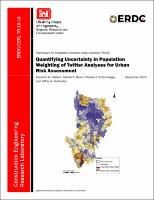Please use this identifier to cite or link to this item:
https://hdl.handle.net/11681/34163Full metadata record
| DC Field | Value | Language |
|---|---|---|
| dc.contributor.author | Bastian, Elizabeth G. | - |
| dc.contributor.author | Myers, Natalie R. D. | - |
| dc.contributor.author | Ehlschlaeger, Charles R. | - |
| dc.contributor.author | Burkhalter, Jeffrey A. | - |
| dc.date.accessioned | 2019-09-23T19:32:07Z | - |
| dc.date.available | 2019-09-23T19:32:07Z | - |
| dc.date.issued | 2019-09 | - |
| dc.identifier.govdoc | ERDC/CERL TR-19-14 | - |
| dc.identifier.uri | https://hdl.handle.net/11681/34163 | - |
| dc.identifier.uri | http://dx.doi.org/10.21079/11681/34163 | - |
| dc.description | Technical Report | - |
| dc.description.abstract | Twitter has increasingly been used to study various research topics such as election predictions, disease spread, etc. However, social media platforms do not saturate the entire population in a study area, especially in emerging nations, only representing more affluent subpopulations. The U.S. Army Engineer Research and Development Center, Construction Engineering Research Laboratory (ERDC-CERL), as part of a project entitled Framework for the Integration of Complex Urban Systems (FICUS), is quantifying the utility of demographic information to inform neighbor-hood-scale social media models. Using the example topic of infrastructure, an open-source model was constructed to collect Twitter data from the metropolitan Philippines area of Manila, geotag tweets to neighborhood grid cells based on language analysis, and produce a sentiment topic map. ERDC’s social media analysis tools incorporate quantifiable uncertainties with specific on-the-ground reporting techniques. By using the Humanitarian Crisis (HC) framework developed by PACOM (another FICUS product) as a model, a framework quantifying the likelihood of being a regular social media user was created to implement a data-driven, bottom-up framework construction nested within a knowledge-based established framework. This framework, and any other produced by the FICUS team serve as case studies for augmenting the military operational environment with quantifiable reduced uncertainties. | en_US |
| dc.description.sponsorship | United States. Office of the Assistant Secretary of the Army for Acquisition, Logistics, and Technology. | en_US |
| dc.description.sponsorship | Military Facilities Engineering Technology Program (U.S.) | - |
| dc.description.tableofcontents | Abstract ................................................................................................................................................... ii Figures and Tables ................................................................................................................................. iv Preface ..................................................................................................................................................... v 1 Introduction ..................................................................................................................................... 1 1.1 Background ..................................................................................................................... 1 1.2 Objective .......................................................................................................................... 3 1.3 Approach ......................................................................................................................... 3 2 FICUS Demographic Models ......................................................................................................... 4 2.1 Technology overview ....................................................................................................... 4 2.2 Initial humanitarian crisis framework ............................................................................ 7 2.3 Social media use in the Philippines ............................................................................... 9 3 Developing the FICUS Twitter Tool ............................................................................................. 11 3.1 Collection ....................................................................................................................... 12 3.2 Geotagging based on language modeling ................................................................... 13 3.2.1 Geotagging methodology functions .................................................................................. 14 3.2.2 Model validity testing ......................................................................................................... 16 3.3 Sentiment analysis ....................................................................................................... 18 3.4 Visualization .................................................................................................................. 18 4 Developing the Social Media Use Framework .......................................................................... 20 4.1 Input data ...................................................................................................................... 21 4.2 Risk value ...................................................................................................................... 21 4.3 Weights .......................................................................................................................... 23 4.4 Unknown components .................................................................................................. 23 4.5 Roll-up computation ..................................................................................................... 23 4.5.1 Favorability functions ........................................................................................................ 23 4.5.2 Quantifying errors and uncertainty ................................................................................... 25 5 Augmenting Twitter Sentiment Maps with Social Media Framework Maps......................... 27 6 Conclusion ..................................................................................................................................... 29 Bibliography .......................................................................................................................................... 32 Appendix A: Social Media Use (Twitter) Framework Technical Documentation .......................... 36 Report Documentation Page (SF 298) .............................................................................................. 88 | - |
| dc.format.extent | 96 pages / 14.62 Mb | - |
| dc.format.medium | PDF/A | - |
| dc.language.iso | en_US | en_US |
| dc.publisher | Construction Engineering Research Laboratory (U.S.) | en_US |
| dc.publisher | Engineer Research and Development Center (U.S.) | - |
| dc.relation.ispartofseries | Technical Report (Engineer Research and Development Center (U.S.)) ; no. ERDC/CERL TR-19-14 | - |
| dc.rights | Approved for Public Release; Distribution is Unlimited | - |
| dc.source | This Digital Resource was created in Microsoft Word and Adobe Acrobat | - |
| dc.subject | Social media | en_US |
| dc.subject | Social media--Analysis | en_US |
| dc.subject | en_US | |
| dc.subject | Population--Analysis | en_US |
| dc.subject | Military operations | en_US |
| dc.title | Quantifying uncertainty in population weighting of Twitter analyses for urban risk assessment | en_US |
| dc.type | Report | en_US |
| Appears in Collections: | Technical Report | |
Files in This Item:
| File | Description | Size | Format | |
|---|---|---|---|---|
| ERDC-CERL TR-19-14.pdf | 14.97 MB | Adobe PDF |  View/Open |